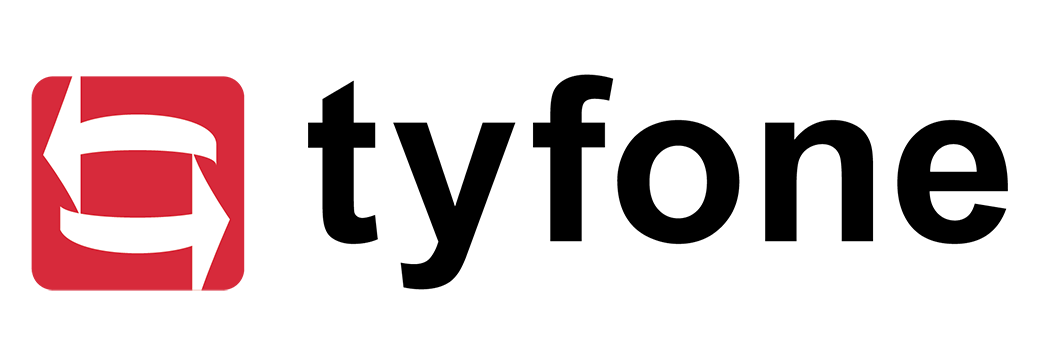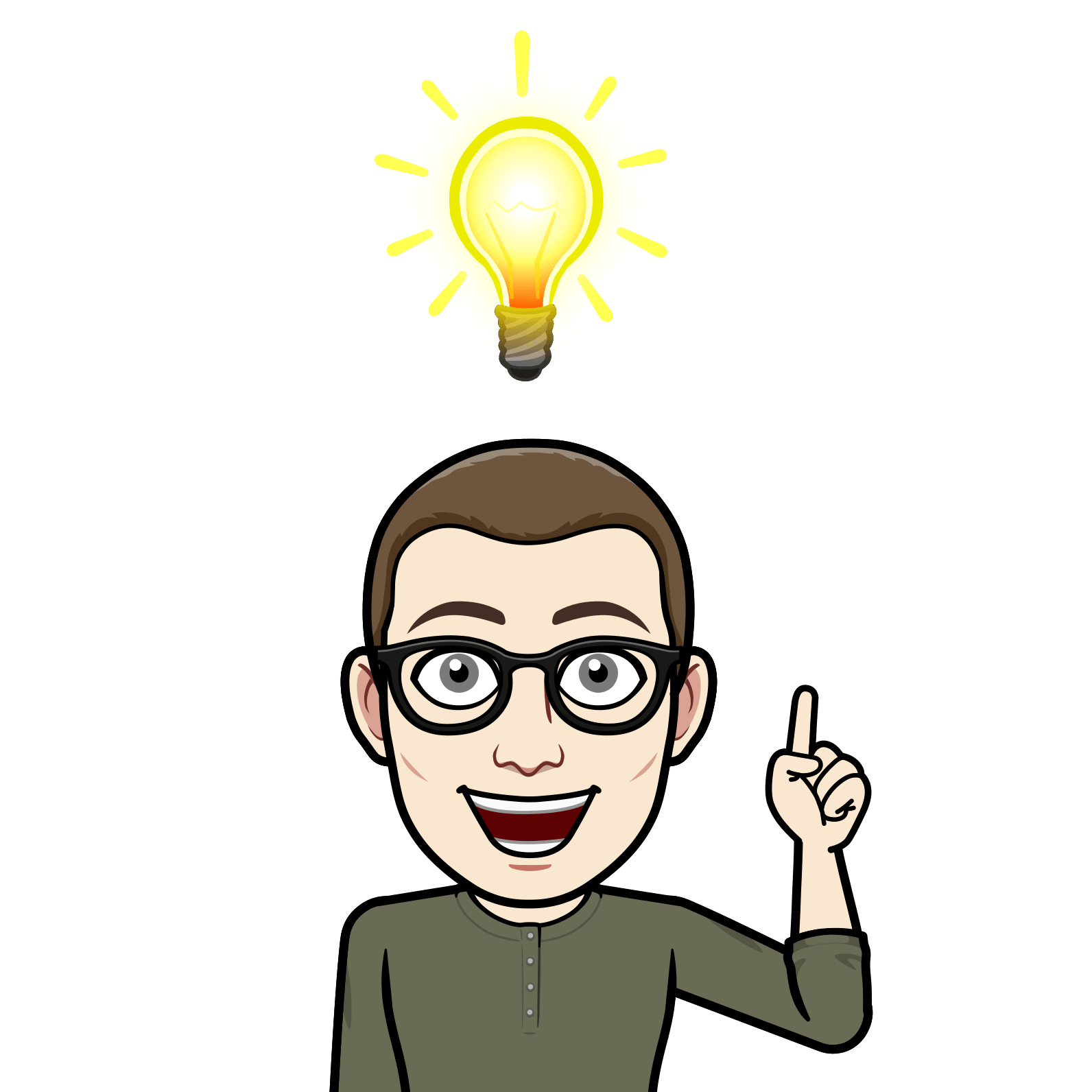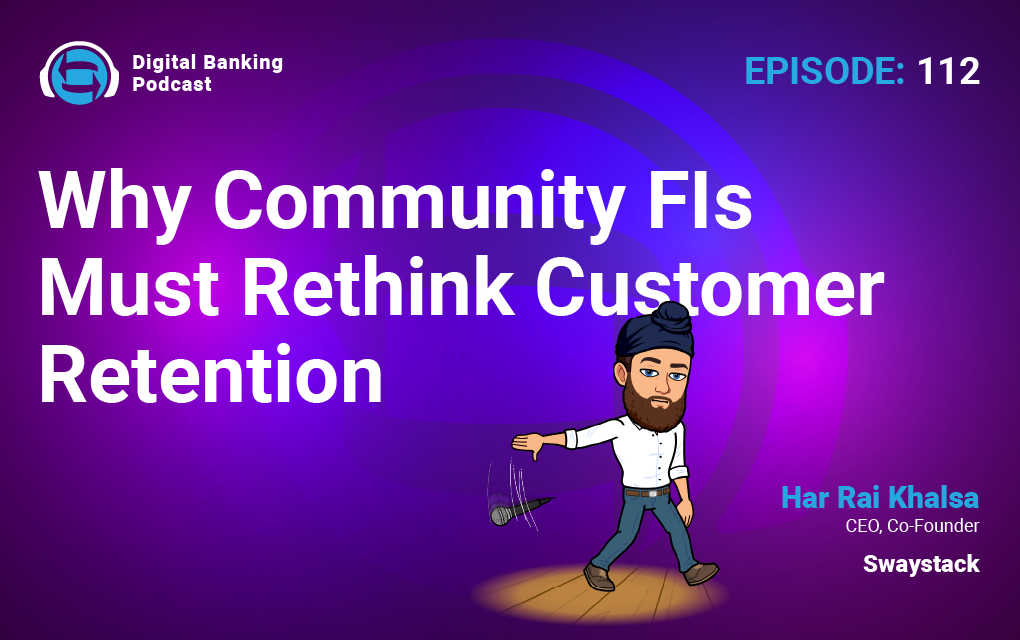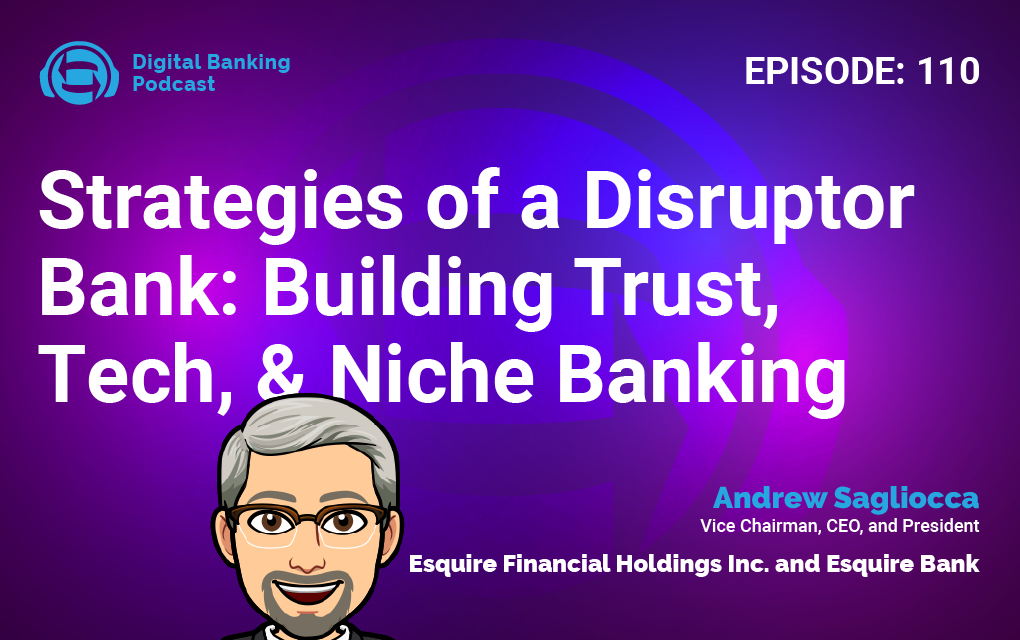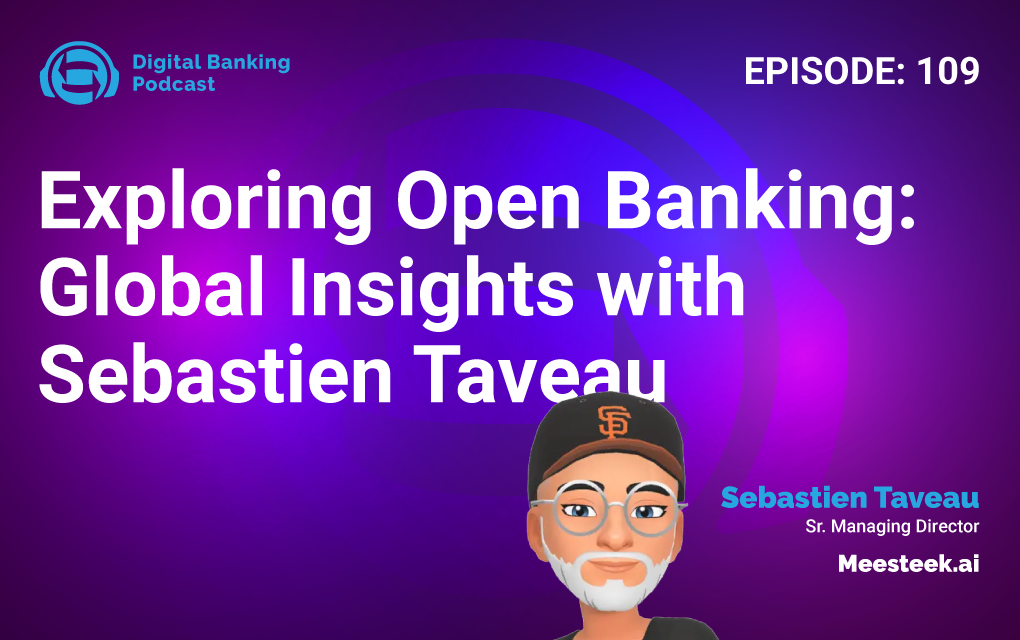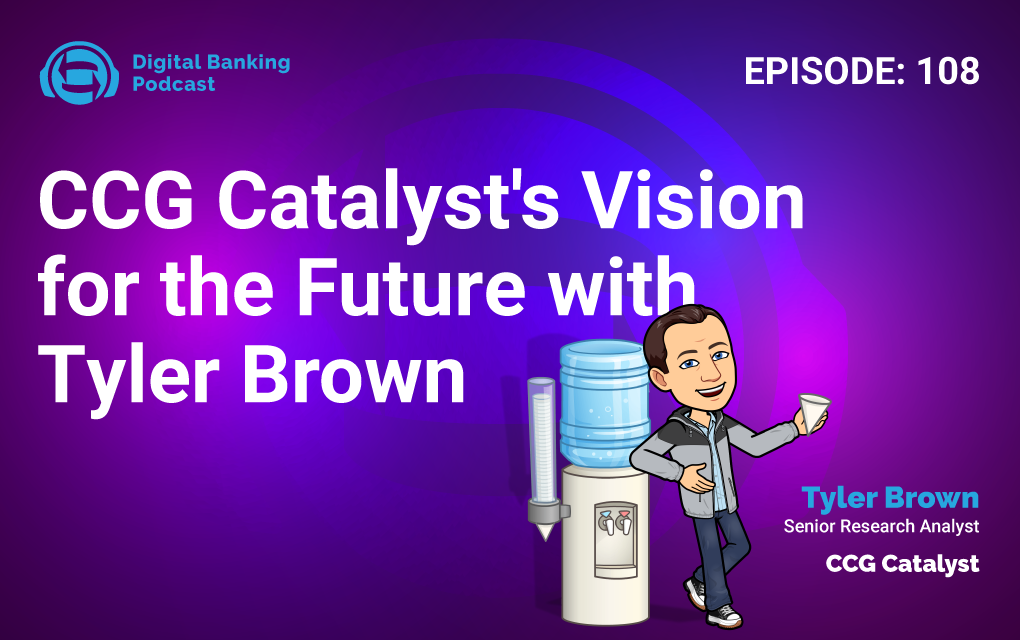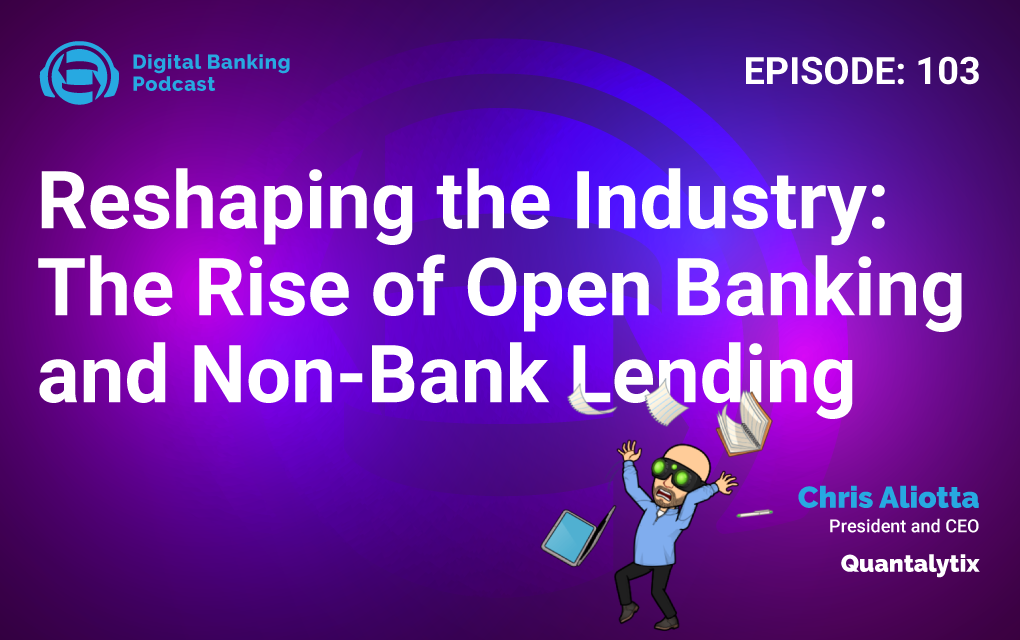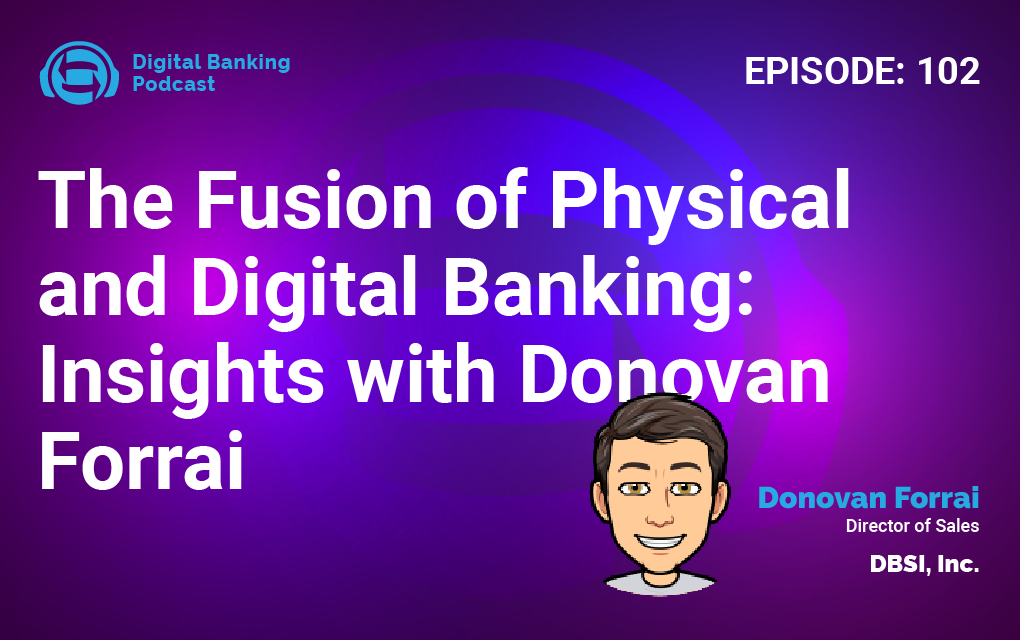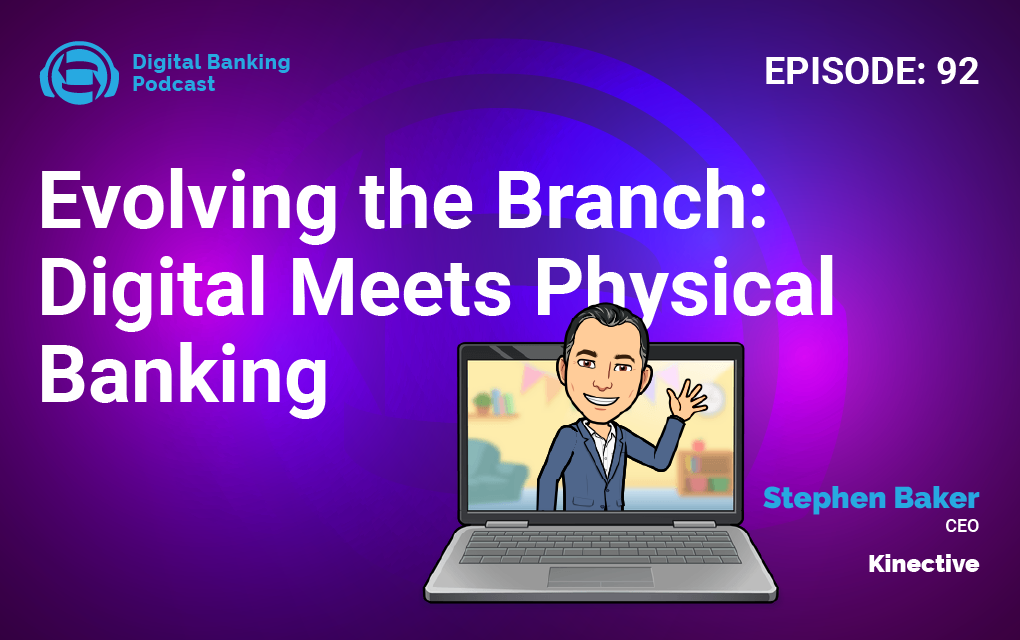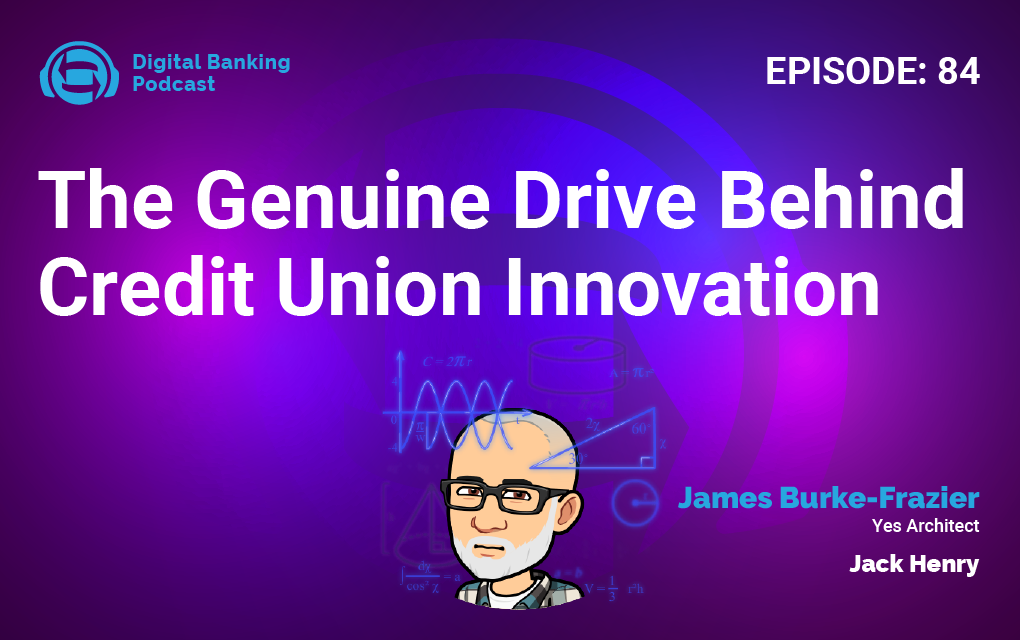Mindset Shifts for Financial Leaders with JR Lay
“I don’t look at things through a lens of disruption, destroying. I look at this through a positive lens, which is transformation. It’s the next step to honor what got us here. But what got us here, is it going to get us there to climb that next peak?”
Episode Summary
In the latest episode of The Digital Banking Podcast, host Josh DeTar welcomed JR Lay, Founder and CEO of the Digital Growth Institute. The episode explored Lay’s journey from punk rock musician to digital banking strategist and the lessons he learned along the way.
DeTar and Lay discussed how financial institutions can move beyond a defensive mindset and embrace transformation as an ongoing evolution rather than a disruption. “Are you playing a game to win, or are you playing a game not to lose?” Lay asked, challenging leaders to rethink their approach to industry shifts.
The conversation covered the role of mindset in adapting to rapid technological change, the importance of vision in leadership, and how AI is reshaping financial services. Lay also highlighted the need for continuous learning and adaptability in an era of digital acceleration.
Tune in to hear how financial leaders can shift their perspective, leverage technology without fear, and develop a strategy that positions their institution for long-term success.
Key Insights
⚡ Digital evolution requires mental evolution
Digital transformation in banking isn’t just about adopting new technology – it demands a fundamental shift in mindset. Success requires leaders to invest significant time in ongoing education, with industry standards suggesting 5-10 hours weekly versus the current 1-2 hours most executives dedicate. This educational gap creates a critical vulnerability in an era of exponential technological change. Financial institutions must move beyond protecting existing assets to actively pursuing growth opportunities. The challenge isn’t just learning new tools, but developing the mental adaptability to thrive in rapidly changing conditions. This mindset shift represents the difference between playing not to lose versus playing to win – a crucial distinction as banks navigate digital transformation.
⚡ Human skills matter more in the AI era
As artificial intelligence capabilities expand, human qualities like emotional intelligence (EQ) and adaptability quotient (AQ) become more valuable than traditional intelligence (IQ). These distinctly human characteristics – empathy, relationship building, and adaptability – provide financial institutions their key differentiator in an increasingly automated world. The ability to combine technological efficiency with human understanding creates a powerful advantage that AI alone cannot replicate. This insight suggests that banks should invest as heavily in developing their teams’ emotional and adaptability skills as they do in technological infrastructure.
⚡ Financial health parallels physical health
The connection between financial wellbeing and physical health grows increasingly evident through data and research. This parallel extends beyond simple correlation – both domains require similar approaches to improvement: education combined with coaching, accountability, and behavioral change. Financial institutions have an opportunity to transform their role from transaction processors to holistic wellness partners. This shift requires moving beyond traditional financial literacy programs to incorporate coaching mechanisms that drive lasting behavioral change. The impact potential mirrors healthcare’s evolution from treating symptoms to promoting overall wellness.
About The Guest

Lay has spent over two decades helping financial institutions navigate industry shifts, digital transformation, and mindset changes to drive growth. He is the author of Banking on Digital Growth and Banking on Change and is recognized for his expertise in blending technology, human behavior, and financial strategies.
Josh DeTar: [00:00:00] Welcome to another episode of the Digital Banking Podcast. My guest today is JR Lay founder and CEO of the Digital Growth Institute. I’ve been following him on social media and reading his email newsletter and books JR is not shy of tough subjects. when I asked him about himself, he said his north star of life is death. Which, really piqued my interest.
his response resonated deeply He said, we all have a finite amount of time How will you use it? Will you let self limiting beliefs and fears hold you back Or will you seize the opportunity? becoming a father of four amazing kids put this perspective in focus.
Not only do I want to make the most of my time, I want to set an example for my children Now, I’m going to let JR walk us through some of his life’s progression and how he ended up being a voice for change for community financial institutions. if you want to keep doing [00:01:00] what you have always done, how you have always done it, with the expectation that the world will keep turning how it always has, you may not want to hear some of the things he has to say today, although I’d argue you probably really should.
JR, what’s going on Glad to have you on the show.
JR Lay: Josh, thanks so much for having me, I’ve been looking forward to this
Josh: I know me too. prepping for today. I don’t know about you, right, but podcasts has become one of my favorite parts of my quote, job, but it is a lot of work, right? And it’s kind of like mentally exhausting. You got the prep, you got to go through all of this, but I’ve been really jazzed about this all day, knowing this was coming.
part of it is because, like I said, you know, I follow you on, on social media one of the things that I appreciate about you. is that you take a lot of times a very provocative stance on things. You’re, you’re willing to have kind of the edgy subjects, but it always comes from a positive place.
even when you’re talking about negative subject matter, you find a way to put it in a light where it’s like, here’s the [00:02:00] positive side I really value that. I like seeing that in my social media feed as opposed to a lot of the stuff I see.
JR: how you perceive the present moment is a lot of times based upon a past experience and we associate an emotion with a past experience, positive or negative, the human mind has about 60, 000 thoughts. Per day and about 85 percent tend to be on the negative side.
if that is our perspective, particularly if we’re starting to think about the future, we must be very mindful. Of the thoughts, because what we focus on will expand running the future growth index with financial brands, their leadership teams, their boards of directors to gain an objective perspective into how they perceive the future. Are they looking at it through hope, abundance, optimism, or perhaps through a lens of fear scarcity, uncertainty, and [00:03:00] doubt, what we’re actually finding is. They’re trending towards that fear, scarcity, uncertainty, doubt side of things. We’ve been running the same exact study from a B2B entrepreneurial lens B2B entrepreneurs are very hopeful.
They’re optimistic about the future, even in uncertain times
Josh: think the entrepreneurial mindset is very interesting that’s a perfect segue. to have you talk through, how you became an entrepreneur, right?
Starting with being in a punk rock band and then getting told by Probably someone you would say now is one of the most amazing women on the planet, That your band sucked.
JR: an important date today. it’s the 23rd anniversary of, the business.
thank you the business has gone through a lot over the past 23 years, some intentional, some unintentional, some forced, some, through just my own will and agency.
if we go back 23 years ago, I was a sophomore in [00:04:00] college. playing in a punk rock band. waiting tables and this girl and I, who I had known since we were 14 years old, were not high school sweethearts there was a girl that sat in front of me that introduced us, who happened to be her neighbor. And I had a crush on this girl’s neighbor through my entire high school career. we ended up in college together, another freshman English class. I liked this girl. something different about her.
So we started hanging out and I had this band She would come to my shows and one day we were sitting in the library she said your band sucked. You need to do something meaningful with your life. that’s all I needed to hear. I quit my band that day. I went down to the courthouse.
Started a web design company in 2002 when the internet was in its infancy. in hindsight. the rest is history. That girl and I would get married four years later, go on and start a family. we’ve been on the highest highs and lows, the entrepreneurial mind.
for me, it’s transforming what many would perceive as [00:05:00] failure along the way into, lessons. It’s just tuition. It’s just something to get to the next peak.
Josh: back to the data you were finding, If you’re in a well established industry, I would think that you gravitate towards fear of being disintermediated versus being on the entrepreneurial side.
You are excited about the opportunity of potentially disrupting someone who’s sitting at the other side of that table going. We’re fine. We don’t need to do anything different, but I’m afraid of the future and what could disrupt me.
JR: for me as an entrepreneur, I don’t look at things through a lens of disruption, destroying. I look at this through, a positive lens, which is transformation.
It’s the next step. to honor what got us here. But what got us here, is it going to get us there to climb that next peak? I think, looking at where we are today if we go back to [00:06:00] 1994, the internet reached mass consciousness We had about 15, 000 credit unions, about 15, 000 community banks when the internet was just coming out. we go back, like, and look at the. The passage of time through a digital anthropological point of view, we have these points like July 5th, 1994, that was the day that Bezos would transform the way we shop online. May 18th, 1995 Wells Fargo would begin to transform how we bank when launching the very first online banking platform. We look at 1997, Netflix begins to transform how we get our media. if you think about the story of Netflix, they have gone through three transformations themselves, very intentionally, in 2007, Netflix [00:07:00] begins to shift the model from DVD delivery. To streaming when read the headlines of Netflix in 2007 making this shift They upset a lot of people because change is hard one of the lessons I’ve learned from my mom is that the only person on planet Earth that really loves change Is a baby with a dirty diaper
Now that’s six years. So half the time they made another transformation of the model when they released their very first made for Netflix production, which was house of cards. And now today, Netflix, we know them as a media platform. So that’s just one example of an organization that has continuously, you could argue one of two ways disrupted themselves. Or they transform themselves as technology has progressed and as, as people behavior, because of the progression of technology as people behavior has progressed as well.
Josh: Yeah, that makes sense. in going back to the statement I made about, [00:08:00] entrepreneurs thinking, Hey, I have the opportunity to disrupt. I think more my point is their mindset is more of a building mindset. as somebody creating something new, whether to transform an existing industry or whatever, you’re still the person saying, I’m going to be the catalyst for, this.
JR: what are we protecting? if we look at the data and in 1994 with the internet, 15, 000 credit and 15, 000 community banks. 2011, 2012, that number had been cut in half. So almost 20 years later, we’re about down to 8, 000 credit unions, 8, 000 community banks, and in 2023, which is an important point of time, because in 2023 we’re down to about 5, 000 credit unions and community banks, about 10, 000 total. I do bring a contrarian perspective, but we got to ask the hard questions if we’re going to get to the next level, are you playing a game to win or are you playing a game not to lose?
all you’re playing is defense [00:09:00] and you’re not attempting some level of an offensive posture, you can play defense all day long, but eventually you’re going to have to score a point.
You can’t play defense the entire time.
Josh: And so that’s what your data was kind of showing in conversations with leadership of community financial institutions, you found a really defensive posture, trying to defend what we have, stay the status quo versus put points on the scoreboard.
JR: and I’m empathetic to that perspective because that behavior is being driven by a belief system. this was the premise of writing banking on change, if we’re not mindful. Of, our minds, which I do believe is the most important technology that we have to master in the age of AI. It is our minds. Our brain is a biological computer. Our mind is software, essentially. What do we do on our phones when we plug them in IOS updates or your Android updates, you get an upgrade [00:10:00] Technology is continuously upgrading at an exponential rate that we can’t even perceive
Josh: Yeah.
JR: if we’re not playing from a perspective rooted in 1999 or 2009 the speed of change is beyond our comprehension. I’ve been studying this for 23 years at the intersection of marketing sales technology, and human behavior, because you’ve got the internal perspective of digital transformation. You got the external of digital adoption and digital behaviors in the context of banking, but Human transformation has to coincide with digital transformation to gain the greatest benefit
Josh: I think, I kind of use the example of, if I take, Lewis Hamilton’s Formula One winning car
JR: Hmm.
Josh: and I put myself in it, I’m not winning the Monaco Grand Prix. [00:11:00] I got all the tech in the world. I got the car. I don’t know how to drive this thing,
JR: Yeah,
Josh: you have to have the mindset and tools to leverage all of this stuff. So yeah, all these advancements in AI is wonderful. But if you don’t actually change the strategy of how you incorporate it into your thinking, into your business model, into how you actually do things, then it’s useless.
It’s just technology on the sidelines.
JR: you bring up a very important point You could have the best car and I love the analogy of Lewis Hamilton. My son’s a big F one fanatic and the amount of training and development that these drivers go through and continue to go through to perform at the level they perform. I don’t think we can gloss over, especially when we’re thinking about digital transformation and human [00:12:00] transformation in financial services, when I was writing banking on change, one of the points of research that we did was around ongoing learning and education. we found that the average financial brand leader is investing. Around one to two hours. about 70 to 80 percent of financial brand leaders
Josh: Hmm.
JR: learning development education, our secondary market research coming out of Silicon Valley says, no, no, no, no. To stay competitive as a leader within this digital world. And now this age of AI, you need to be investing at a minimum. Five hours per week in ongoing learning, development, education upwards to 10 hours
per week. And so whenever I bring this into leadership teams and boards, they look at me like, what are you talking about?
I don’t even have time for one to two hours a week. You’re asking me to double that, how important? is that going forward into the future? [00:13:00] Because the rate of change is going to require us, and this was something from a futurist that wrote back in 1970s, Alvin Tulford, said the illiterate of the 21st century will be those who cannot learn, unlearn, and relearn.
Josh: I didn’t intentionally use F1 as an example, but you think about those guys, right? it’s not just about the driver or the car. think about the things they are evolving in the car every single year.
They’re like, can we get 0. 2 percent more downforce with, a 0. 1 percent reduction in drag that minor. change could have a massive impact on their ability to win races. the technology is having to change and sometimes it’s really, really small changes and sometimes it’s major drivers have to use that extra downforce. They’ve got to be able to say, I can take turn one now an extra three miles per hour. where’s my turn in point now with an extra three [00:14:00] miles per hour versus before. if they just run the same race as if the car was the same they’re not maximizing the potential of the car anymore. all of these things have to be up leveling kind of harmoniously. And that takes dedication, that takes work, it takes effort. And I argue that once you get into the elite levels it is even less about massive changes, right?
It’s not like we’re going from a car with square wheels to round wheels. we’re improving our downforce by 0. 2%, right? But when you get to that elite level, and when we get to the point where we’re having to compete on such an incredible scale, those little tiny things that we’ve got to improve on that are going to make big impacts.
JR: you’re making a fantastic point about the car, about the driver, about the tech. But then let’s take that to a bigger level. There’s also the team now that is surrounding and supporting the driver, car and tech, that [00:15:00] team, that driver, they’re all working towards a unified vision, a purpose that’s greater than the present moment. ultimately, it’s to win, which comes back to the point of are you protecting playing defense or are you playing the game to win? when we’re talking digital, these micro improvements over an extended period of time, they begin to compound and that creates exponential value beyond of what we can perceive today, because you’re thinking, what good is 1 percent today? be 1 percent better every day over the course of the next 365 days. you have grown exponentially as a team, as an organization.
Josh: I like that you bring the team into it because, if we think about, digital banking for a community financial institution. buy the best platform, now you have the best F1 car And then your driver doesn’t know how to drive it. Your, your, you know, your leader isn’t prepared with a [00:16:00] strategy to capitalize on all these bells and whistles let’s say you’ve got both of those things solved.
You have a visionary CEO willing to take risks and push the envelope with technology. You get the pest technology and then your team that runs it doesn’t support it, doesn’t believe it. That’s like having your pit crew. Thinking, Oh, you know what?
This is just another day at the office. I worked at Jiffy Lube last week and I rotate tires. And so when this guy pulls into the pit, like, you know, we got a minute, we’ll get the tires changed and we’ll take a peek at the brakes, make sure they’re good, right? Versus a team that understands the mission is, Hey, we are, two tenths behind the leader.
If we can get our pit stop three tenths faster, we put our guy a tenth ahead.
JR: You said a key word about the leader. vision I’ve written about vision in both banking on digital growth. As well as banking on [00:17:00] change, there’s some ancient wisdom here where there is no vision, the people perish. if the vision is more of the same people will perish. maybe not today, maybe not tomorrow. one of my mentors Dan Sullivan. changed my perspective about the future. He said, you always have to make your future bigger than your past, And so vision is key it comes to this next level of growth that I feel hopeful and inspired for community institutions, because it does come back. To the people, this is still a very people centric Financial stress is getting worse. for people, but then the question is, are we still just operating based upon loans and deposits?
Or could we ask ourselves the hard question why are we doing what we’re doing? Why are we adopting this new technology? What is the opportunity [00:18:00] to help other people get beyond the pains they’re experiencing today and provide them hope to a bigger future?
Josh: I love doing this podcast so much. And I think I can probably put words in your mouth and say it’s why you like doing it too being able to have these kinds of conversations it’s not like this is stuff we don’t necessarily know. I always find it really interesting when somebody says something that hits me at my core.
But it’s so simple. when you say something like, a great piece of advice is your future should always be bigger than your past. you’re like, yeah, no, duh. But I never said that. You know, I never, I never actually said that. I’ve never vocalized that. I never operationalized that.
this industry is such an incredibly important industry to the health and lives of our fellow Americans in being able to provide financial stability and security. That’s a pretty [00:19:00] cool thing being done by community financial institutions. So that’s why I think people like you and I get so fired up and passionate the opportunity is colossal not just opportunity for them to grow their business, right?
It’s opportunity for them to do more of the amazing good work in people’s lives being financially free is incredibly freeing
JR: It is. that passion and purpose is why I’ve done what I’ve done because I believe this is a noble cause. This is a noble industry. There’s such a strong correlation between a person’s financial wellbeing and their physical
wellbeing. The data, it’s just becoming more and
whenever I do diagnostic work with leadership teams and boards, And we survey, well, why should I open an account? Why should I apply [00:20:00] for a loan at your institution? the common patterns come back around. Well, we have great rates amazing service and awesome products. and I wrote about this in banking on digital growth yeah, well, what if everyone’s saying the same thing? what is missing in these responses? that I think is going to be critically important in this age of AI where commoditization is happening at a much faster rate. We have knowledge, wisdom, expertise, empathy, human characteristics and traits. Oh, and by way, we’ve got this amazing technology too, but we have this humanity. being able to meet people where they’re at, ask, listen, hear their questions, hear their concerns, provide a path towards a future, and then give them the coaching and the accountability they need to get to that future. I’ve [00:21:00] been beating up on financial literacy, financial wellness, financial education. that’s fantastic. We’ve taken the first step, but we need to layer on some sort of coaching mechanism to the education because knowledge alone is not going to change behavior.
you’ve got data at the lowest level, which is ones and zeros. You got knowledge, how to interpret that data at the highest level, though, is wisdom and being able to apply that. And so just like I’m talking about this need for education externally combined with coaching to help people transform their beliefs and behaviors around money to achieve financial freedom The same is true internally, just because you gain a new perspective. There are four steps that lead to human transformation. the first step is to see things from a different angle, from a different perspective. And maybe someone who is watching or [00:22:00] listening to our conversation here, perhaps they’re thinking and seeing things differently because the, the follow to seeing something different is you’re going to begin to think different.
Your thought patterns begin to change. It gets very hard to unsee what you have seen. And then the last piece of this is when you go to What’s the third step? And I’m curious, Josh, when you begin to see different, when you begin to think different, what’s the next step?
Josh: started to act different.
JR: And that’s the belief of 98, 99 percent of leaders that I’ve worked with over the years. And I’ve asked this question thousands of times. And my question then is, Are you really going to act different because you’re thinking different? Because how many of us, and I’ll be the first one to step in front of the line that says, I know there are things that I need to do different in my life, whether that be personally or professionally, or probably a blend of both, but I am failing to take action.[00:23:00]
Josh: just because
JR: For one reason. Because there’s a fourth step that sits between the thought and the action. And that’s the feeling and the emotion. we have to reach a point as leaders where our feeling, our emotion to act, to be different is greater. And in many cases, exponentially greater than the feeling and the emotion to maintain the status quo. more times than not, understanding human behavior is that emotion. To take action is going to be rooted in some sort of pain because we’re more likely to take action to avoid pain and loss than we are to achieve some sort of
gain basic behavioral economics. what are we looking at when it comes to the transformations we need to make as an organization to continue to achieve digital transformation? What are the potential pains, the pitfalls, the roadblocks that we might not be [00:24:00] aware of, that we might not even be able to see right now. It’s just because we don’t have the knowledge, the perspective. at the same time, we have to be very careful that if we’re operating based upon feeling alone, that too can be very dangerous For example, you might go to a conference, I’m starting to speak out about this. Like, great. You’re at this conference. I’m doing a closing keynote or something. You’re going to go home and you’d be fired up and you’re going to come back and you give all these great ideas, everyone else on your team. What are you gonna do about it?
Josh: Yeah.
JR: It’s going to be more of the same because you’re operating from a state of heightened emotion, That’s temporary, it’s like it’s, it’s inspiration and inspiration. It’s like a light or a candle it’s eventually going to dim out over time. Motivation is like a muscle. It’s going to eventually fatigue to bridge that gap between the thought and the action, yeah, it’s feeling an emotion, but there’s gotta be another, another [00:25:00] guard in there so that we don’t, once we. Are now demotivated because we’re back at the office and no one is seeing what we’re seeing because we were the ones who went to the conference.
We were the ones who got fired up. The safeguard there is coaching. There’s got to be an internal component of coaching are you willing to go to this level of vulnerability to get real and to get open, to get honest with yourself and with your team. I think it’s the guards that keep people back.
Josh: as you were talking about that, it really harken back to, I think, we were even just talking about, physical health and financial health.
That’s so true in both of those areas too, right? I know that I should probably eat a little bit healthier. I know that I should probably exercise more.
So I’m going to think differently. But how many of us actually act on it? I know I probably should stop spending so much money on stupid trinkets on Amazon. Do I [00:26:00] actually act on it? really creating foundational pillars that will be the element of change that will get you to the stage of action that’s going to separate whether you make it there or not.
this brings up something interesting that I really wanted you to talk about. you’ve referenced a few times the books, but we haven’t actually talked about them. you have two books out, banking on digital growth and banking on change wrote banking on digital growth.
almost five years ago now
JR: Yep.
Josh: So almost five years ago. And when you publish that, right, you were like, this is the best piece of work that has ever been published. This encompasses all of my knowledge at this time. And now you look back on it. And you’re like, ah, that was wrong. That was wrong.
I mean, that’s still foundationally right. But I would change that. Right. So talk to me a little bit about even just your own self reflection you were willing to put this stuff on paper, put your name and picture on it and put it online for people to pay their hard earned money for. And then you’re like, Hey, I had to write [00:27:00] another one because some things have changed and being able to have that self awareness and admit that and then take the evolution of action on those changes.
Talk through that process.
JR: I’m right until I’m proven wrong and I’m willing to fall on my own sword. I’m right until I’m proven wrong because there’s been a new data set that I can take and digest and reflect on. when I published banking on digital growth, it was supposed to have been published in March of 2020, we had no idea what was going to happen. I was super stoked and excited. I had been working on this thing for about 18 months and had this huge keynote speaking tour lined up around the world. then COVID happened and shut everything down It was a curse and a blessing. having a positive perspective comes back into play when everything [00:28:00] shut down, I got the first email saying we canceled our conference and then it was just like a waterfalls like canceled, canceled, canceled.
I was like, Oh, this sucks. and I fell into the gap. I was griping about problems for about a week. Until my wife, pulls out that brutal, harsh truth. That then led me to launch the podcast. you take a negative experience and you’re able to transform that into a positive one. Cause I had COVID ever happened. I don’t think I’d probably go to launch the podcast. And now I’ve done almost 500 episodes. you’re always learning and gaining perspective here. And maybe we’ll loop back on that point. And so in reflection, whenever I wrote banking on digital growth, I realized I did, I made a huge error. I had to write another book to make up for my sins in, in, in the error was, it was the heart of banking on digital growth. I presented a formulaic approach where DX plus HX equals growth, meaning a positive digital [00:29:00] experience combined with a positive human experience, is the path to growth. then COVID happened and I was observing. What was going on in the market and with clients I Missed the most important element in this formula, the employee experience All change, all transformation that leads to future growth, starts with the individual, it starts with the self, you transform yourself, you transform your teams, teams are made up of individuals, you transform your teams, you transform your organization, you transform the lives of your customers and members, you transform other people in your communities, we got to start figuring out what it’s going to take to inspire Transformation of people. And that was the context of banking on change. It was going deeper into the human experience now we look at this from a formulaic approach where E X plus H X in parentheses, meaning a positive experience leads to a positive human experience can then be [00:30:00] multiplied exponentially by D X. So your digital experience becomes the exponential multiplier of the employee and human experience. Delivered in just a different channel, a different context.
Josh: one of the things that I thought was interesting is you were talking about as you had that self reflection through the pandemic. It’s always interesting to see how people react to massive catalysts of change, right? there’s always a kind of a microcosm of things that are causing us to have to do changes.
it could be anything from, maybe a new CFPB rule or something like that. and that may seem like a big change in the moment, but I would argue in comparison to what the pandemic did to us, It pales. And so there’s going to be these moments where.
We are kicked into the pool of change and you’ve got no option other than to figure it out because change is here and it is unavoidable. to your points, what do you do with that new knowledge? What do you do with that change and how does that impact your [00:31:00] future and your future strategy and your thought process on the world and things?
for you, you had the realization I missed a key element in that first book. I missed that employee experience element or how that rounded out the human experience of someone interacting with a financial institution. what do you think were some of the things that you saw as light bulb moments for leaders at financial institutions?
And conversely, what are some of the things that you saw people do in response?
JR: I think COVID allow for the greatest amount of innovation and quote, unquote, progress in financial services that we have seen maybe ever in the shortest amount of
Josh: Yeah, I would
JR: I remember early on, I was talking to my wife, I said, I talked about this with the podcast too, back in 2020, Give it three or four years the [00:32:00] pendulum is going to swing. Leaders are going to go back to the way things were before. once we’re out of the danger zone, back to the status quo and that’s exactly what I have observed probably end of 2023 going to 2024. the, the progress begin to slow, the focus begin to shift the, the speed at which changes were happening, slowed.
I think a lot of it was the fatigue of speed. it’s like running, COVID was a sprint and you can only sprint for so long before you tire out. It’s one of the reasons I always recommend that when you’re talking about change and transformation, think of it as a marathon. you’re going to have to train for that. I’ve run a couple of marathons myself and you don’t get up one day and think, Oh, I’m going to go run 26 too. No, you, you, you have a training plan and you follow the plan build up your endurance over [00:33:00] time and then it becomes race time. you go run the race and you might have the best training plan.
You might feel like you’re prepped. And this has actually happened to me a couple of times. you go out on race day, temperatures off too much humidity. It’s not cool enough in the morning. So you have to adjust your plan in real time. And that’s an opportunity that I see going forward for institutions Think about the annual planning event. Take this down to 90 day planning and execution cycles. Think about this on a quarterly basis because so much can change as we are observing now, particularly with all the releases happening around AI. It’s like November 30th, 2022 was when chat GPT hit the market. And I get it, the idea of exponentiality is very hard to wrap your mind around, particularly because we, me included, [00:34:00] we’re all like feeble linear thinkers. but if you think about this, a year after the iPhone released and it took Uber almost six years to go from zero to a hundred million users. It took Instagram 30 months, to go from zero to a hundred million users. It took TikTok nine months to go from zero to a hundred million users. When chat GPT came out November 30th, 2022, it took. Two months to go from zero to a hundred million users. Like that’s an exponential adoption curve of watching human behavior. Yet I was just doing a keynote at a industry event, a bunch of associations, state associations came together, CEOs and boards. I asked the group, How many of you have played, experimented with some sort of AI model? [00:35:00] Most well known would be ChatGPT.
80%, 85 percent have not yet.
Josh: It’s crazy.
JR: And we’re two and a half years in on this
thing. And what I’m observing is their behavior with these models. for example, ChatGPT, they’re Googling ChatGPT. I get it. I’m very empathetic, but this is where the belief system has to change.
the very first time you Googled was probably going to your eighth grade dance. everyone thought they knew what they were doing, but no one has a freaking clue of what they were doing. And that’s where we’re at with AI right now. We’re at the eighth grade dance stage. everyone thinks they know what they’re doing, but we’re all learning together you gotta get back in the game.
Josh: yeah.
JR: You just got to get in the game and learn through the experiences and use the Socratic approach to wisdom where Socrates, the final wisdom is, I know [00:36:00] nothing,
Josh: I want to come back to AI, but you were talking about something that I think is really worth going back to for a minute.
JR: sure.
Josh: And you talked about the fatigue of the speed of change.
JR: Mm hmm.
Josh: in the early days of the pandemic, I remember talking to a good friend who’s a CEO of a credit union.
he talked about one of the realizations he had about his organization in the early stages of the pandemic. He said that prior to the pandemic, they were trying to institute the ability for some of their key employees to work from home.
And he was like, I’m not even joking We were a year into this and each time we got, okay, IT has figured out how to do it. Technically HR was like, ah, but we have this problem here in this policy and then HR finally gets it figured out. And then IT is like, oh, no, there’s something over here. And then all of a sudden ops is coming in over here and it’s like, [00:37:00] oh, we can’t do it for this reason.
And he’s like, the pandemic hit and we did it in one week. we got everybody together. We figured it out. We made a decision. We committed. We executed. And in one week, we had a work from home policy, the tools for people to do it, and it worked just fine. so what that told me was that we spent a year doing something that we should have done in a week.
What I think would be really interesting is, I’m gonna probably call him right after this episode ends and ask him, What does that look like today? you still finding? That there are things that take you a year to do that you could have done in a week. Or, conversely, did you maybe find out, yeah, like technically we could have done it in a week, but I burnt my people out doing that.
And we did it because it was a special necessity. is there a pace of change that, to your point, like we’re trying to sprint the first mile of the [00:38:00] marathon and then realizing, oh crap, we’re gassed out, man. Like, this was a bad idea. Or have you figured out that there’s maybe an in between and maybe, you sprinted to get your work from home policy because you knew you needed to, like you were being chased by a bear.
maybe you realize that a lot of the things that were happening in your institution, you were walking that marathon when you probably could have jogged it at least. I’d be really curious to find out what he has found in that kind of pace of change.
I’d be curious to see what that looks like.
JR: It would be very interesting because I shared in banking on change is the 90 day growth method. just like there are four seasons, spring, summer, fall, winter, there are four seasons that we must cycle through as individuals, teams, and organizations. We [00:39:00] learn in the spring. We think in the summer. We do in harvest in the fall. Reap the fruits of our labor and then in the winter it’s a great time to review and reflect on the progress we’ve made over the previous year. if you can compress those four seasons, learning, thinking, doing, and reviewing down to a 90 day cycle, you increase the speed at which you are going through a transformational initiative. there’s a gap in learning. also a gap in reflection and review because many leaders, get stuck in the fall, reaping the fruits of the labor, just doing the work, not creating intentional space and time to review and reflect on the progress we’ve made the lessons we’ve learned and how to apply that to our next iteration when we do create that space and time to review and reflect, that’s some of the greatest education that we can get that no book, no podcast, [00:40:00] no conference is going to give us. It’s through our own reflection of our experiences in banking on change. I put forth a model where EQ plus AQ is greater than IQ in the age of AI.
we’re already looking at, The singularity and the theory that artificial intelligence is going to surpass human intelligence. I kind of buy into that to a point. Let the artificial intelligence surpass my intelligence. does that bother me? Because I know that my EQ and my AQ is going to be greater than my IQ to where my emotional intelligence and my ability to connect and be with people. meet them where they’re at when combined with my AQ, which my adaptability quotient or my adaptability intelligence. That’s a superpower that’s going to allow us as, as people to differentiate ourself from the machines. [00:41:00] And the AQ is an area that I’m very concerned about in FinServ with banks, with credit unions. Because when I work with these teams and organizations and I asked them, I said, okay, you want to increase your AQ? Yes. AQ is like EQ. It can be benchmarked. It can be measured and it can be coached over time.
You can increase your adaptability quotient. And so I asked these leadership teams and these boards, I’m like, so you want to do this, right? I said, yes. Tell me how to increase my AQ. Okay. when we wrap up here and you go back to your room tonight, I want you to take a cold shower, either tonight or in the morning. ice cold, as cold as you can get it and just stand in that cold water. I promise you, you’re going to increase your AQ, your adaptability quotient the amount of pushback and resistance I get. I used to get upset from it, but I really try to take a [00:42:00] stoic philosophy and just life in general. why am I getting upset when people, don’t want to change? Why am I getting upset when they want to stay where they’re at? That’s their thing.
But if you want to do this, your ability to adapt to environmental changes, the cold plunge, the cold therapy is scientifically proven so that if another event like COVID happens, you’re probably going to surf the waters instead of getting caught in the undertow.
Josh: it’s funny when you were talking about, people going to conferences and hearing the motivational keynote and they get all raw, raw, raw, and then it fails to turn into action so many times,
it’s interesting.
I go to a lot of these conferences, I hear a lot of these speakers and so many times I sit back and go, How is this really what you’re doing you’re telling me all these wonderful things that you’ve done, but what you’re not telling me is how to make this applicable in my life. Like what are the use cases?
What are the steps and tools that I can use to implement this? And what can I expect to see [00:43:00] as my ROI for adapting to this? and so many times I’m, I hate to admit, a little bit of a pessimist in the back corner of a lot of these. And I was at one, gosh, this was probably about two years ago now, JR.
Have you ever heard the guy, the Iron Cowboy speak?
JR: Yes.
Josh: That guy was awesome. Huge fan. Because he ended each of his minor points, and ended the whole thing with a major point. With tools you could actually take home. for those who have not heard him speak a lot of what he’s talking about is your ability to be resilient, you have to face challenges and adversity. he made a comment that has always stuck with me. He said, the hardest thing that you face in life is the hardest thing that you’ve faced in life. if the hardest thing you’ve ever faced in your life is someone said something mean to you on Twitter, it’s a pretty low barometer.
and so I started thinking about that, for my wife and [00:44:00] I, my wife is a young breast cancer survivor. we went through that early in our marriage, that was the hardest thing we’d ever been through. what’s funny is, now, even my wife, we have a bit of a dark sense of humor about it as you can probably imagine, even just the other night, something was going on and it would have been a pretty challenging thing.
And my wife looks at me, JR, and she goes, at least it’s not as bad as having your, you know, what’s chopped off. And I was like. You got a fair point, babe. so that became her new barometer. She’s like, I’ve been through that. Like somebody saying something mean to me on social media.
She’s like, I could not care less. That ain’t going to phase me one iota. what I took from that lesson from the iron cowboy was looking for other ways to. we’re now five plus years removed from her cancer journey, That stuff starts to become fleeting and you start to forget about, I got through that.
And so you almost need to [00:45:00] reintroduce new challenges, new things in your life that create adversity so that you are prepared for real adversity. ever since then I’ve started doing cryotherapy, right?
And if you haven’t done it, I encourage it,
Standing in there for three minutes at negative 230 degrees. It sucks. But I tell everybody, I get out of that cryo chamber. And my first thought is who’s got a tiger. I want to fight that thing.
JR: You feel like a badass and I’m so glad first and foremost, thanks for sharing that about you and your wife. I’m happy that she’s healthy and y’all got to the other side of this thing, but it did, it built resilience for her, for you together as a couple
Josh: Yep.
JR: there’s a great book on this subject called the comfort crisis. There’s some ancient wisdom, quote unquote, where we are in a cycle of time. there was a book that came out in 1997 [00:46:00] called the fourth turning. And it was very prophetic to the world that we’re in right now. And I guess that’s one of the reasons I can sit where I sit, be fairly calm, be very hopeful, be very optimistic. not let a lot rattle me right now, because what the fourth turning looks at is the, the world works in 80 year cycles, more or less that these authors identified back then. And we are in a season of winter. And what gives me hope is what comes after winter it’s spring. if you think about where we were last year in 2024, we go back 80 years before it was 1944, that was the year we were at the pinnacle of world war two.
We dropped the bomb pretty dark time in hindsight. We go back 80 years before that. 1944 to 1864. We’re in the Civil War. [00:47:00] If we go back 80 years before that, 1774, right at the start of the American Revolution. if we’re aware of these cycles of time we can use that knowledge to our advantage as leaders to be mindful and aware that we don’t get sucked down by the challenges and complexities that many are feeling right now. and if you’re not doing hard things. for example, you talked about cryotherapy. I have a cold plunge on my back porch set at 37, 38 degrees. I hop in there for two minutes. It doesn’t get any easier,
but it builds your mental resiliency. Otherwise you risk getting stuck in the cave of complacency
the cave of complacency, beckons all of us. It’s like the sirens of, of the old mythology, you know, calls us in to [00:48:00] the safety of the warmth by the fire. But what we don’t see in the cave of complacency or all of the bones scattered from others that have gone in there seeking solace from the storm of life, They never made it out, got comfortable and ended up dying in there. the opportunities to come out of that cave, keep climbing that mountain. As you talk about going to these conferences and, listening to the speakers and I’m doing the keynote speaking I’m not going to lie. I have had a lot of personal conflict of why the hell am I doing what I’m doing?
Josh: Hmm.
JR: If no one is going to take any action on this,
nothing changes.
Josh: Yeah. we need catalysts for change, but we also need the ability to respond to change, that comes back to your adaptability score. I think that goes to, the biodome experiment, when they first started the biodome, they couldn’t grow [00:49:00] trees. they couldn’t figure out why. the lesson is they realized it was because there was no wind in the biodome. the trees never faced adversity. They never developed the need. To send down deep strong roots and grow good foundations as soon as they got tall enough They just fell over.
All they had to do is introduce wind into the biodome and they grew trees We humans I think are so much the same way and when we get stuck in Complacency and trying to create a comfort zone for ourselves We never grow. We never change. We never develop the strength to weather the storms going back to my wife I’s example, I want to be incredibly respectful of understanding that we had a very positive outcome from that, that so many others are not as blessed to have had,
But with our experience and our outcome of it, people think that we’re crazy sometimes when we say this, but we’re both glad we went through it. We are. Because like you said, you know, it made, it made her stronger. It made me stronger. It made us stronger as a [00:50:00] couple. my wife and I, basically don’t fight, because nothing comes up where we’re like, this little annoyance or this little thing we’ve got to deal with, it’s just not that big of a deal in the grand scheme of things,
And so having those opportunities in life to look for the positive in it and say, I’m going to use this as a tool in my arsenal. To be prepared to adapt, to be prepared to change and to be prepared to pivot when the opportunity presents itself or is required of me, I’m going to be strong and resilient and able to face that.
And that’s such a powerful force that we can apply in both our personal lives, but also our professional lives, right? If we stagnate in our professional lives, then you’re not changing, you’re not growing.
JR: it’s the call to action and I want to give everyone watching and listening a very practical tool because I do think it’s the [00:51:00] tools that you can use. To unlock your next level of growth, exponential growth, as I write about in Banking on Change, Exponential growth I define as when you are growing as an individual, both personally and professionally, at the same time. Your personal growth can lead to your professional growth. Your professional growth can lead to your personal growth. Your personal stagnation can lead to your professional stagnation, and vice versa. one of the tools that I want to unpack is ideas for growth, I D E A S, we’ve given a lot of different perspectives I really appreciate how you’ve guided this conversation, Josh. When we look at what we’ve discussed, get a piece of paper and write down three insights that you have gained.
Don’t overthink it. Just three insights that come top of your mind from what we’ve been talking about. [00:52:00] And from there, I want you to decide circle what you believe the number one insight is for yourself. then expand upon why you believe that this is the number one insight that you’ve gained from the conversation because when you expand upon it and give why you’re associating meaning with an insight Okay. Because it’s the meaning that’s, going to motivate you to do the next, which is the actions. once you’ve assigned meaning I want you to write down the three actions that you’re going to take next to turn this insight into action, to begin to move forward, to begin to make progress, to begin to create momentum, you can do this also at the end of a conference or an event end of listening to any podcast, the most important piece of this, once you have your top three insights, once you’ve decided on what the number one is for you, and given it meaning said, why is this the top one for myself, for my team, for my organization?
Once you’ve written down three actions to create some momentum, you got to share [00:53:00] it. share what the insight is, why it’s important. And the three actions you’re going to take that’s going to create accountability and confidence when you get that accountability and share this with someone else they hold you accountable and check in, Hey, did you do anything with this or did you just live in this podcast? It’s the accountability piece that is where the transformation happens it comes back to seeing thinking and feeling different to then take action
Josh: I think you just wrote my LinkedIn post for when this, podcast drops. before I let you go, I wanted to come back real quickly. To the conversation we’ve been having. We’ve thrown the buzzword AI out like 600 times in this, hour long conversation.
But, I don’t think we’ve really pulled together one of the things we were talking about previously in this episode, When we’re talking about AI, we’re also talking about the rapid evolution of things. are you prepared to adapt to those changes and what are you going to do with that?
[00:54:00] there are immutable laws that govern the pace at which technology evolves and innovates. we were even joking about, some social media posts on AI before we started recording.
there’s still an incredible misconception that these AI tools don’t work very good. Or, you know, don’t have good use cases. I would park one argument that we won’t even touch, which is just that tells me you don’t know how to use them in the first place, but to the pace at which these things are getting better.
I agree, right? we’re still in the infancy, but tomorrow, I’m not talking about future state I’m talking about literally February 12th tomorrow. It’s going to be better. In February 13th, it’s going to be even better than how much better it was from the 11th to the 12th.
that change, especially for my banker friends, think about it this way. It’s like compounding of money. [00:55:00] If you look at it tomorrow, it makes a little bit of a change. If you look at it two days from now, it makes a little bit of a change, maybe a little bit more. If you close your eyes, go to sleep, and wake up 10 years later it’s changed a lot.
Don’t get caught in that changes a lot all of a sudden. That’s my comment on AI, but I’d love to get your perspective as a closing take.
JR: I think that’s a great word to wrap things up with its perspective, this entire conversation, the next evolution of financial services is going to be rooted in perspective. The next level of growth is going to be rooted in perspective. one of the exercises that I use in my keynotes and my workshops is I ask a very uncomfortable question.
I love seeing people squirm because it does make them uncomfortable. growth never happens in the comfort zone You work out, you want to grow your muscles. you gotta get uncomfortable. And the question that I ask is this, is how [00:56:00] old were you in 1994? It’s a question for you, Josh. How old were you in
Josh: eight.
JR: You were eight. I was 13 and in 1994 that was the year the internet as we were talking about before, reach the mass consciousness of people. And if you think about all the changes that we’ve experienced over the last 30, 31 years, since that moment in time, Your experience as an eight year old was different than my experience as a 13 year old, our experience was vastly different than someone who was, say, 30 and 94. And what I like to do is not even let’s talk about AI for a minute because it’s just the next evolution of technology.
what I want to do is provide a whole new perspective outside of our context, and go all the way back to 1881 a hundred years before I was born. I was born in 1981. You were born in, I would assume, 87, 88. [00:57:00] So let’s go to 1881 and let’s go from 1881 to 1925. you got 43 years of time. You’ve got 43 years of perspective, context, and framing. I want to look at two different angles with this. I want to look at transportation first. If you were born in 1881, you were just coming alive at the time that transportation was moving from horse and buggy to rail lines getting placed in your town.
By the time you were 19, 20, 25 years old. The car, the automobile was now coming online. The Wright brothers were flying the very first airplane. So you now have early air travel. And if you look back to the Wright brothers, like, oh, that’s not that great. They only flew for like 10, 12 seconds. Yet here we are taking things for granted. When we get in our airplanes and we wifi on [00:58:00] a flight out to the
So 1881. To 1925, you’ve gone from horse and buggy to trains, to automobiles, to planes because commercial flight is now really becoming a thing in there, you know, early to mid twenties, so early on, but it’s becoming an actual thing. Let’s look at communication. If you’re born in 1881, the primary mode of communication, be writing letters. If you want to get it somewhere quick pony express, but around the time the rail lines were being laid. What was going up next to the rail lines? You had
telegraph wire, telephone telegraph.
And I think this is important because the modern day telegraph, we’re still telegraphing. That’s just texting.
Josh: that’s true.
JR: So we have to observe behavior in the context of time, which comes back to perspective. you go from the telegraph to the telephone, [00:59:00] telephone to the radio, radio to the TV. But then from the time that the TV came out to the next big progression, yes, you have computing power of the 1960s and seventies and computers get smaller and faster you can talk about Moore’s law and the doubling and whatnot. But it was the internet that was the next big leap. now here we are with this whole age of AI and artificial intelligence. The other thing I’m very interested in. Is another perspective of AI, is authentic intelligence because knowledge is getting commoditized with these large language models. What is not commoditized is the human experience. It’s what we’ve done in this conversation today. Josh, you have an experience and I have an experience. those who are watching and listening they have an experience. so you get this triangulation of three different perspectives. we’re able to do this [01:00:00] asynchronously with someone watching or listening and they’re going to walk away with a whole different perspective is going to be the next level when you take, when you combine the EQ and the AQ to see, think, feel different to then act different, into the authentic intelligence That each and every one of us has, that comes through our wisdom that we’ve gained through our lived, learned, and shared experiences.
Josh: Yeah, I agree. It’s an exciting time to be alive, but I think every generation has probably said that, right? There was the generation that, never thought flying was going to be possible, that in their generation saw commercial air travel, there’s a lot of us that are thinking that there’s things that are impossible that are probably going in our lifetime. And it’s going to be interesting to see how those things come about.
JR: important for financial services, not just happen in our lifetime, but extend and [01:01:00] expand our lifetime and our lifespan and our health span. Because that’s going to make us rethink this whole idea around money, finances, health, wealth, well being. It is truly an exciting time to be alive.
Josh: this has been an exciting podcast. I had a blast. before I let you go, two final questions where do you go to get information about what’s happening in the industry? Any shout outs that you’d like to give?
JR: I look out, Peter Zion, Peter Diamandis, are two thinkers that I, Spend a lot of time studying with, I appreciate their perspective. I try to look outside of the industry to gain a much broader context, a much broader perspective, because by studying different trends and patterns outside of the industry, we can begin to hypothesize what’s going to happen inside the industry.
Peter Zion, Peter Diamandis, Dan Sullivan, over strategic coach. Those are three big thinkers that, inspire my thinking.
Josh: if people want to connect with you or learn more about your work or find your books, or, [01:02:00] if you’re an executive at a institution or board member and want to be smart and get this dude to come out and talk to your leadership team, how can they connect with you
JR: Send me a text, my cell phone. It’s 832 549 5792. Just send me a text, say hello. Happy to gift you a copy of Banking on Change. All you have to do is text me, or you can grab it off of, you can spend 30 bucks and grab it off Amazon, I can also gift you a digital copy and help guide you forward with that book.
Josh: I appreciate all the insight. like I said, if you don’t already, please follow JR on social It’s nice to see that kind of positive perspective a lot of times on it. just a good way start my morning. So, follow him and, thanks for taking your time to come and be on digital banking podcast me, sir.
JR: thanks for me, buddy.
